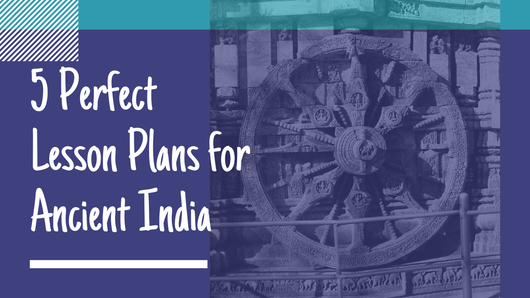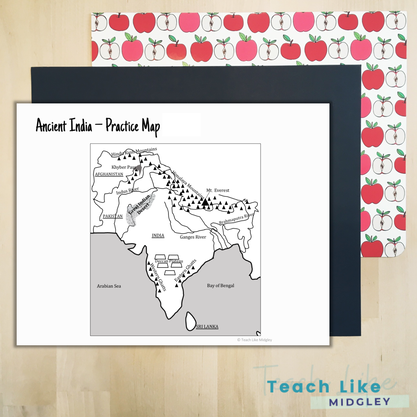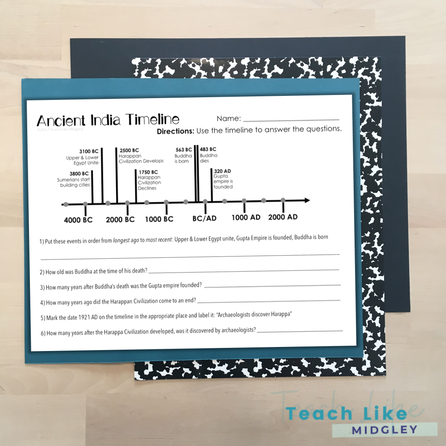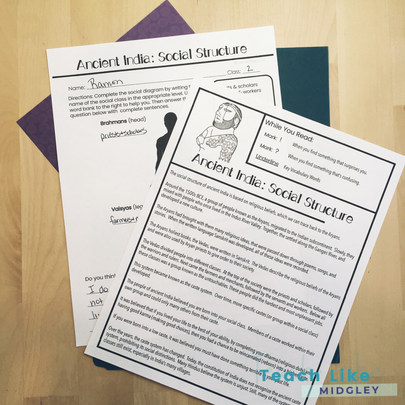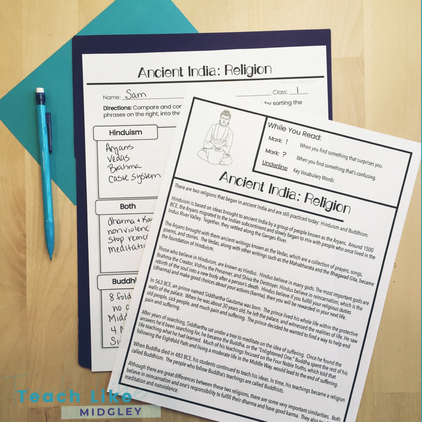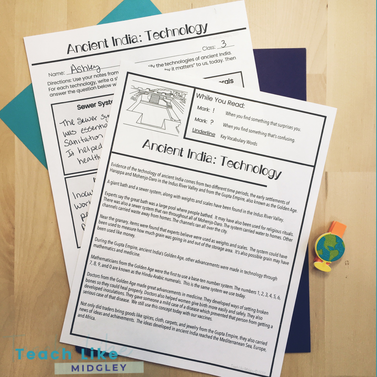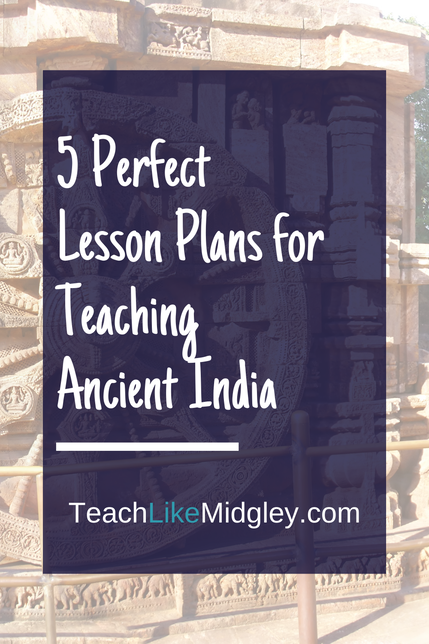5 Perfect Lesson Plans for Ancient India
Lesson plans for teaching ancient India have probably been the most challenging of all the civilizations we study.
There doesn’t seem to be a lot of materials out there, especially not that will rival Egypt, Greece, or Rome.
While Mesopotamia always presented its own set of challenges, being a bit confusing with all the different civilizations within the area, I always found India to be even more challenging.
Every time I came across materials for teaching ancient India, they were based on comparing Buddhism and Hinduism.
There doesn’t seem to be a lot of materials out there, especially not that will rival Egypt, Greece, or Rome.
While Mesopotamia always presented its own set of challenges, being a bit confusing with all the different civilizations within the area, I always found India to be even more challenging.
Every time I came across materials for teaching ancient India, they were based on comparing Buddhism and Hinduism.
While we can agree the beginnings of these two major world religions is important and should be taught, then we can also agree they should not be the main focus of the entire ancient India unit.
In this post, you will learn about 5 major components that should be included with your ancient India unit, which will make your lesson planning easier – without a doubt!
Location
Certainly you’ll want to start out with maps and learning about the geography and location of where this civilization began.
Most people think ancient India began in present-day India. But this simply isn’t true!
The first settlements that are considered part of ancient India actually began in present-day Pakistan. This is where learning about present-day countries of an ancient region becomes helpful.
Most importantly though, you will want to address the geographic features of the area and identify what made the area good for settling, which ultimately will come down to establishing a stable food supply.
Most people think ancient India began in present-day India. But this simply isn’t true!
The first settlements that are considered part of ancient India actually began in present-day Pakistan. This is where learning about present-day countries of an ancient region becomes helpful.
Most importantly though, you will want to address the geographic features of the area and identify what made the area good for settling, which ultimately will come down to establishing a stable food supply.
Two Time Frames
When you begin to learn about ancient India, you should notice that there are two major time frames to consider.
Early settlements began along the Indus River Valley in present-day Pakistan. Although there is not a lot of information to be known, you should definitely start here and focus on what we do know based on artifacts found in Harappa, Mohenjo-Daro, and Lothal.
For reasons experts still are unsure of, these early settlements were abandoned.
In time, the people who remained in the area joined up with a traveling group known as the Aryans, and together they began a new time period of ancient India. They developed a new culture and settled throughout the Indus River Valley and the Ganges River Valley.
It is during this second time frame that the written language Sanskrit emerged, along with the beginnings of Hinduism and the caste system.
While your lesson plans will focus a great deal on the second time period, do not forget to include the first, where artifacts show that note-worthy technologies developed.
Early settlements began along the Indus River Valley in present-day Pakistan. Although there is not a lot of information to be known, you should definitely start here and focus on what we do know based on artifacts found in Harappa, Mohenjo-Daro, and Lothal.
For reasons experts still are unsure of, these early settlements were abandoned.
In time, the people who remained in the area joined up with a traveling group known as the Aryans, and together they began a new time period of ancient India. They developed a new culture and settled throughout the Indus River Valley and the Ganges River Valley.
It is during this second time frame that the written language Sanskrit emerged, along with the beginnings of Hinduism and the caste system.
While your lesson plans will focus a great deal on the second time period, do not forget to include the first, where artifacts show that note-worthy technologies developed.
Social Structure
We know that religion plays an integral part in ancient history on so many levels.
We see the pharaoh of Egypt, a god in human form, at the top of the social structure and considered all-knowing.
In Mesopotamia the ziggurat, a religious temple, is the largest building of an entire city-state.
Many were killed in ancient Rome simply because of their religious beliefs.
Ancient India is no different. The organization of their society was based on religious writings. Holy books known as the Vedas, were brought to the Indian subcontinent by the Aryans. These holy books became the foundation for the religion, Hinduism. The books also include descriptions for organizing society using the caste system.
The ability to improve yourself in society was based on religious beliefs of reincarnation. You were born into your caste, and there you remained for the duration of that life. How you lived determined what caste you would be born into, for your next life.
Understanding this complex system is essential to understanding life in ancient India.
We see the pharaoh of Egypt, a god in human form, at the top of the social structure and considered all-knowing.
In Mesopotamia the ziggurat, a religious temple, is the largest building of an entire city-state.
Many were killed in ancient Rome simply because of their religious beliefs.
Ancient India is no different. The organization of their society was based on religious writings. Holy books known as the Vedas, were brought to the Indian subcontinent by the Aryans. These holy books became the foundation for the religion, Hinduism. The books also include descriptions for organizing society using the caste system.
The ability to improve yourself in society was based on religious beliefs of reincarnation. You were born into your caste, and there you remained for the duration of that life. How you lived determined what caste you would be born into, for your next life.
Understanding this complex system is essential to understanding life in ancient India.
Religion
No study of ancient India is complete without learning about the beginnings of the world’s major religions Hinduism and Buddhism.
Hinduism in particular is one the world’s oldest religions that is still practiced today.
While some may argue Buddhism is not a religion at all, since there is no god(s) as part of the core belief system, but it is at the very least, a way of life.
This is where comparing and contrasting becomes a common exercise when learning about these religions. Although they are each unique, still they both focus on stopping reincarnation, practice meditation, and promote nonviolence.
Hinduism in particular is one the world’s oldest religions that is still practiced today.
While some may argue Buddhism is not a religion at all, since there is no god(s) as part of the core belief system, but it is at the very least, a way of life.
This is where comparing and contrasting becomes a common exercise when learning about these religions. Although they are each unique, still they both focus on stopping reincarnation, practice meditation, and promote nonviolence.
Achievements
Many don’t realize the advancements made in ancient India, particularly during the Gupta Empire.
They developed a base-10 number system known as the Hindu-Arabic Numerals that we still use today.
The use of inoculations or vaccinations was a concept first used in ancient India.
Early forms of the game chess were found in the Indus River Valley.
It is a great perk to studying history, learning where these ideas originally came from.
They developed a base-10 number system known as the Hindu-Arabic Numerals that we still use today.
The use of inoculations or vaccinations was a concept first used in ancient India.
Early forms of the game chess were found in the Indus River Valley.
It is a great perk to studying history, learning where these ideas originally came from.
Ready to Roll Materials...
Remember that organizing and simplifying your content does not mean that you are “dumbing it down” It just means that you helping your students comprehend complex concepts and teaching them how to break it down. In fact, when you organize and simplify your content, you will find that your students are able to gain a much better understanding and will be eager to learn more.
Often when students don’t like history class, it’s because they don’t understand what’s being taught. I’ve had many parents express how surprised they were because their child never enjoyed history before, but left my class loving it. I can tell you that this is not because I teach elaborate, entertaining lessons. It is because I teach with structure and remove the complication. My goal is that this blog post and my resources will help you do the same.
Now you know some of the essentials components to include into your ancient India lesson plans.
But if the thought is still overwhelming for you, consider these done-for-you resources that will have you ready to teach your unit in a jiffy.
The Ancient India Planning Checklist will give you a more detailed account of what to include in your unit plans.
The Ancient India Lesson Sets that align with my 7 part structure will provide you with multiple resources for teaching all of the essentials within your unit.
The Ancient India Unit Test will help you wrap up your unit covering all the basics as well.
Often when students don’t like history class, it’s because they don’t understand what’s being taught. I’ve had many parents express how surprised they were because their child never enjoyed history before, but left my class loving it. I can tell you that this is not because I teach elaborate, entertaining lessons. It is because I teach with structure and remove the complication. My goal is that this blog post and my resources will help you do the same.
Now you know some of the essentials components to include into your ancient India lesson plans.
But if the thought is still overwhelming for you, consider these done-for-you resources that will have you ready to teach your unit in a jiffy.
The Ancient India Planning Checklist will give you a more detailed account of what to include in your unit plans.
The Ancient India Lesson Sets that align with my 7 part structure will provide you with multiple resources for teaching all of the essentials within your unit.
The Ancient India Unit Test will help you wrap up your unit covering all the basics as well.
You May Also Like...
Let's Connect...

Welcome! I'm Hillary Midgley, a veteran 6th grade teacher.
I create educational materials and develop curriculum for other teachers. I specialize in teaching students how to learn through my Study Skills Curriculum. I have established fundamental classroom systems and structures for teachers to help them streamline their classroom. And my passion is teaching ancient history through engaging activities with foundations in academic skills. Here you will find resources on all of these topics and more. Learn more about me here.
|

